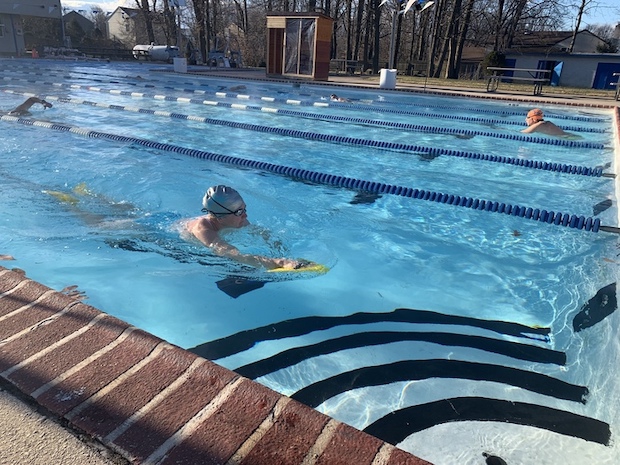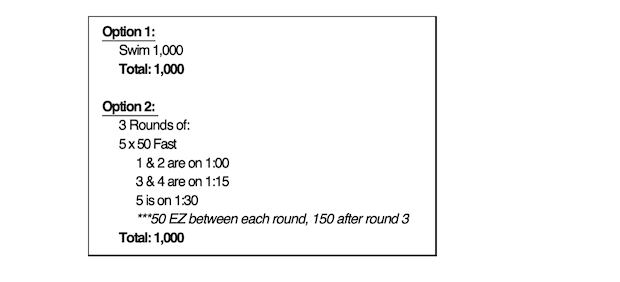On Swimming: Practice Fast to Race Fast

Hi everyone! A quick introduction before I jump into the good stuff: my name is Aaron Page and I’m a former competitive swimmer who will be contributing to Slowtwitch. While in high school here in New Hampshire, my team won 4-straight state championships and we re-wrote our school’s record board over those years. I then went to a DIII college in Maryland where I swam for 3 of my 4 years and participated on a couple of school-record setting relays. Admittedly, I was not a fan of practices and swam to survive rather than get better, and as a result took a hiatus from the pool for a while after graduation. I’ve since returned to the pool and found I appreciate and need the hard work and 10-years post-graduation am as fast as I’ve ever been. I want to use this forum to share some things I’ve learned over the years, the mindset I train with, some of the tools I use to improve speed and technique, and much more. Cheers!
As someone who frequents the local YMCA pool, I see a lot of different types of swimmers. One thing that most of these patrons have in common though is that there aren’t a lot high heart rates when they’re done and exiting the facility. From Masters swimmers to triathletes, the idea that “more is better” seems to be a prevalent idea. But when that “more” isn’t as efficient as it could be, there’s a lot of improvement being left on the table.
University of Texas coach and legend Eddie Reese has a quote that has really stuck with me since returning to the pool:
“If you’re not swimming bad at some time of the year, you’re not trying to get better.”
It’s easy to jump in, swim or pull a couple of long sets, and call it a day. Maybe 3,000 yards were completed in large chunks, but you leave the pool feeling refreshed and loose rather than having the feeling of making progress on becoming a better swimmer. Not every practice should feel great, the same way that not every run or bike session should feel good. Good things come out of truly hard work.
Below are a few key ideas that I’ve implemented in my training that I wanted to share with everyone that I believe will help lead to improvements in the pool. While it might take some time to get used to and not all practices will feel great (see quote above), these will help lead to faster swimming over time.
Break up those long swims into smaller portions that you can swim faster
I remember a day when swimming 500 yards continuously seemed like a daunting task and the only way to survive was to swim it slowly with the only goal being finishing. Today I take a different mindset that allows me to attack these longer yardage sets in chunks, with the focus being on speed while still getting the exact same distance completed.
As an example, here are two options for a set that could get you 1,000 yard each, with one being a long swim and the other being mostly very fast swimming where your goal is to hit the fastest pace possible that you can hold throughout the set. And with the intervals being slow enough to allow for some rest, you can really attack this one. I’ve done this a handful of times and it can hurt.

Kick!
I got teased quite a bit growing up because of my natural tendency during practices to drag my feet along behind me during long freestyle sets. Then I always wondered why my legs gave out during races…
Please, please, please kick. The great thing about long swims is that you don’t need to hold a 6-beat kick throughout the duration of your swim: you can get away with a 2-beat kick. And even a 2-beat kick will help your technique and endurance. You’ll better be able to keep your hips at the surface of the water when swimming without the aid of a pull buoy or wetsuit. Additionally, you’ll save your arms from doing 100% of the work in the water.
My recommendation for swimmers of any level: always include a dedicated kick set in your practices. They can vary in intensity (see Tip #1!) but dedicating some time to working on only kicking each practice will prove dividends over time.
Use different tools to get different results
In the near future I’ll do a more in-depth “What’s in the bag?” but in the interim, there are a few staples that you can use to add variety and get different stimuli while practicing.
Pull Buoy and Paddles: The staples of any gear bag. Pair them together, or use separately. Just be sure to use a paddle that is the right size for your current strength and technique. I'm a big fan of the TYR Catalyst Stroke Training Paddles, as they offer a variety of sizes and can let you hone in on strength or technique work.
Strap: If you want to get really crazy, you can use a strap to tie your feet together, eliminating your kick completely. This'll fix a poor streamline in a hurry. Doing this without a pull buoy can get tough extremely quick, so you can pair with a pull buoy to get some longer distances in. You can buy one, or you can achieve the same effect with an old bike tube that you tie off.
Fins: Great tool for building power in your kick. Word of caution to those of you who race in a pool or open water…don’t become too reliant on these during practice. Also, don’t use long fins. Find a pair of shorter fins to better emulate a true kicking motion. I currently love the TYR Stryker Fin.
Snorkel: I love this tool for helping focus on body position and getting rotation during freestyle. By eliminating the breathing part of the stroke, you’re able to keep your head down and really concentrate on the catch and rotation of your body. I’ve used nothing but the Finis speed snorkel for the past few years and don’t think I could be convinced to change.
Train with a Group
I saved the best for last. I’ve done a lot of training both on my own and with a group and my best, most memorable practices are hands down the ones I do with others. Not only do you have someone in the lane next to you to race, but the camaraderie you build during an hour or more of suffering with others is unique. Additionally, you most likely won’t always be 100% responsible for programming, which can lead to more variety than you may be likely to do if you did your own programming 100% of the time.
Whether it’s with a triathlon club, Master’s swimming group, or just a group of friends you have at the local pool, I strongly encourage everyone to plan your workouts with others where you can so you can get the most out of your time in the pool. Get in, race, and get faster.

